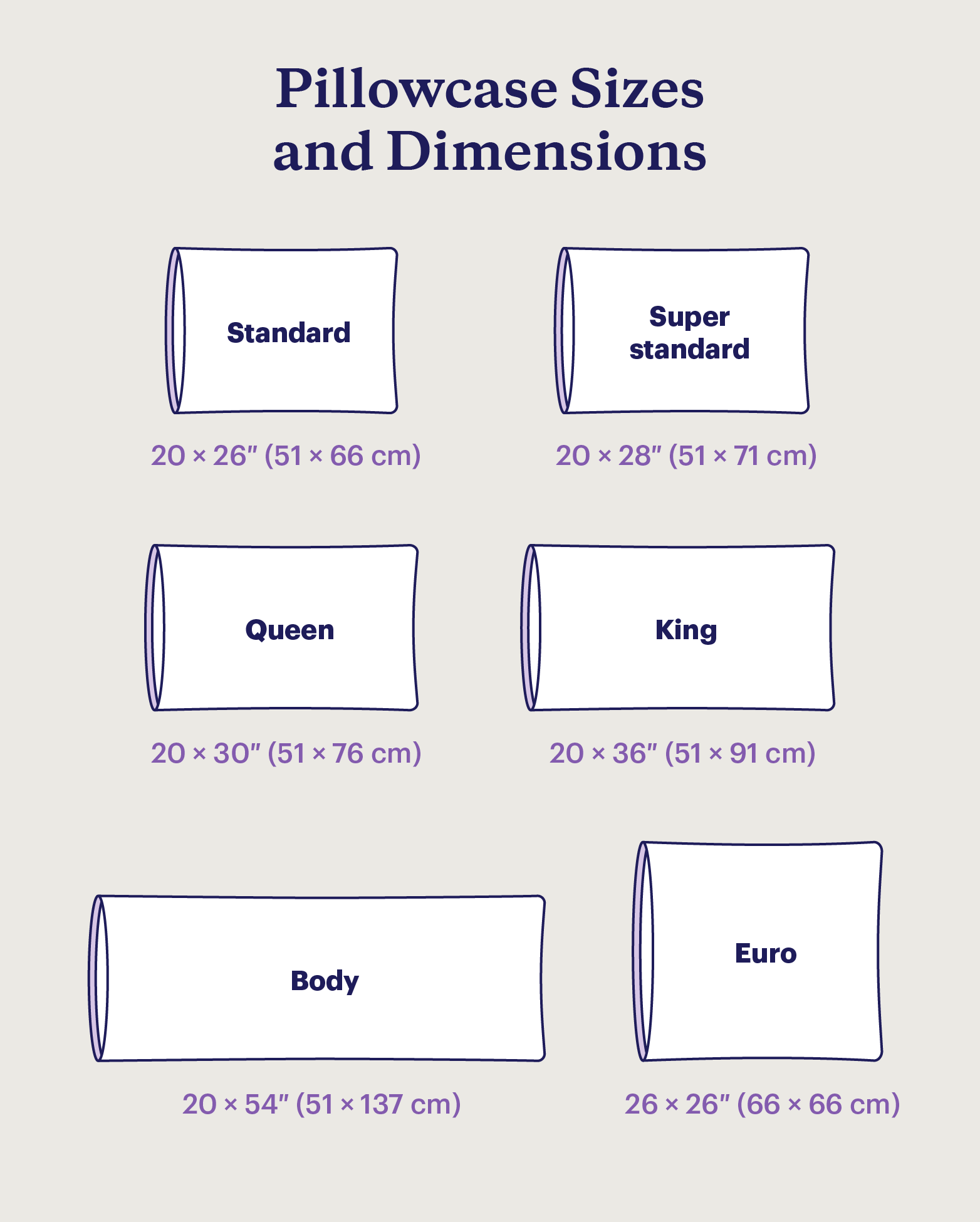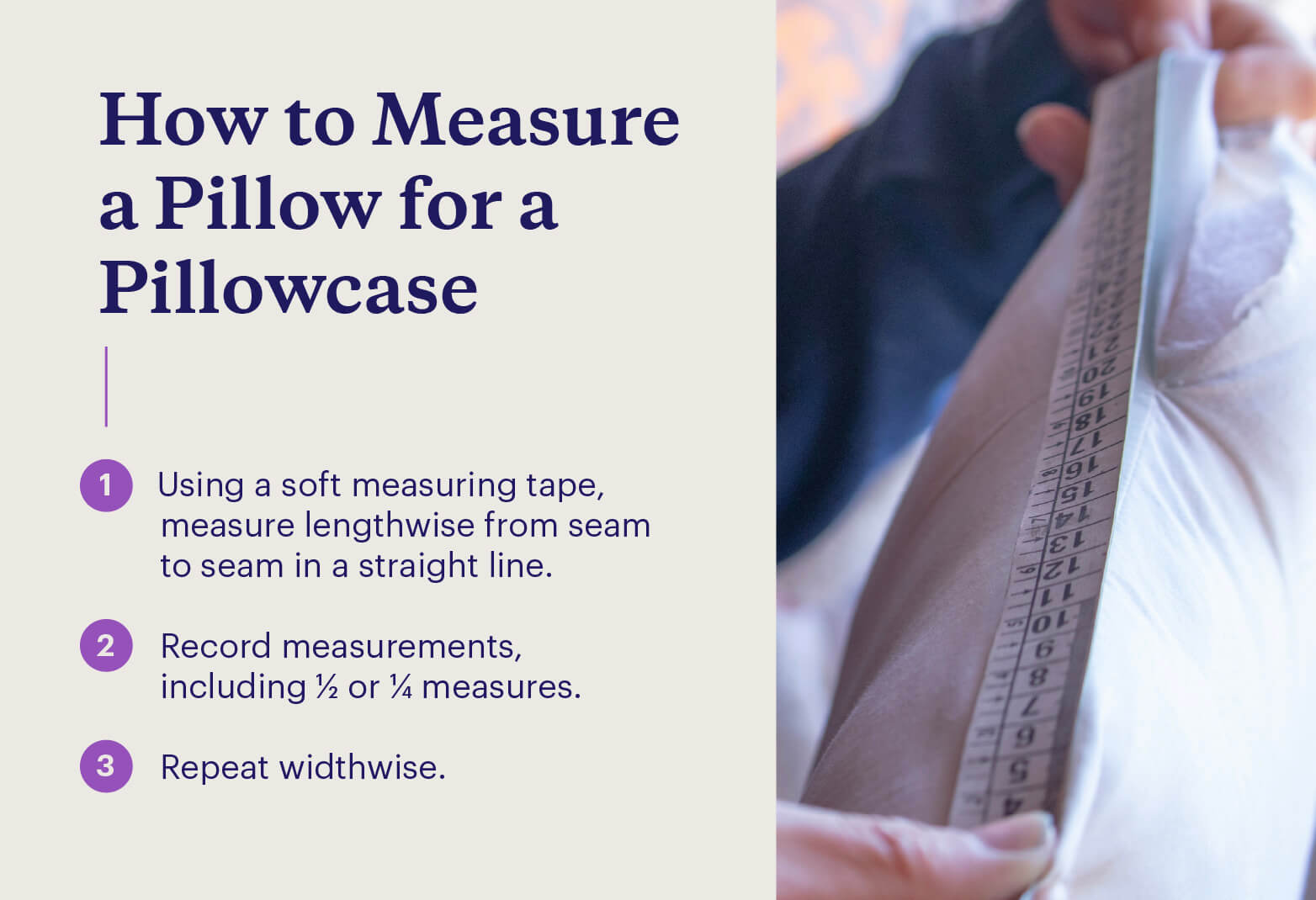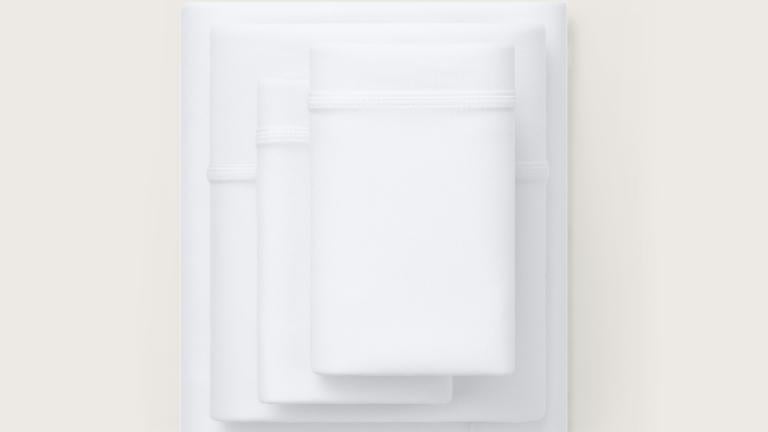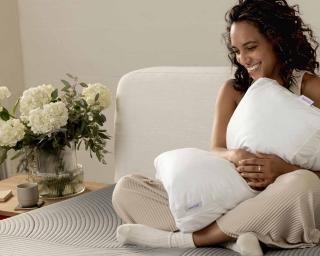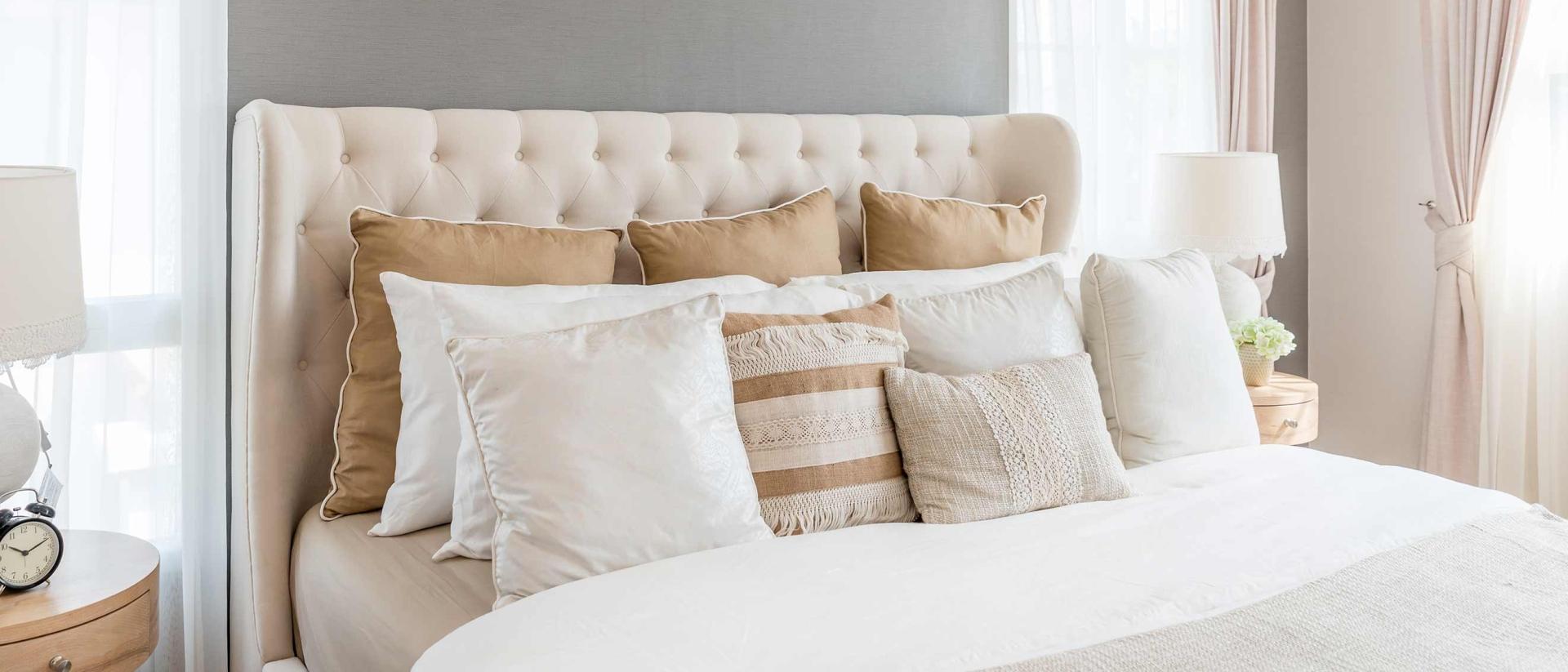
Pillowcase Sizes and Dimensions: Guide + Chart
Key Takeaways:
- There are many sizes of pillows. It’s essential to know your pillow size before buying a pillowcase. Measure your pillow from seam to seam using a soft measuring tape.
- The standard pillow size is 20-by-26 inches or 51-by-66 centimeters. Other sizes include queen, king, super standard, Euro, and body.
- Pillowcases impact comfort. An improper fit negatively impacts comfort and therefore sleep quality. Sleeping without a pillowcase can also increase the risk of allergies, skin conditions, and how often you have to wash and replace your pillows.
Pillowcases are often overlooked when building your ideal sleeping setup, but in truth, they impact your overall comfort levels significantly. Luckily, finding the correct pillowcase sizes for ultimate comfort and fit is relatively straightforward.
Keep reading to learn more about different types of pillowcases, how to measure them, and how to choose the right one for you.
Pillowcase Sizes and Dimensions
Pillow size | Measurements (in) | Measurements (cm) |
Standard | 20 x 26 | 51 x 66 |
Super standard | 20 x 28 | 51 x 71 |
Queen | 20 x 30 | 51 x 76 |
King | 20 x 36 | 51 x 91 |
Body | 20 x 54 | 51 x 137 |
Euro | 26 x 26 | 66 x 66 |
Standard Size Pillowcase
Dimensions: 20-by-26 inches or 51-by-66 centimeters
One standard pillow fits well on both twin and twin XL size mattresses, while two side-by-side fit well on both full and queen mattresses. Because this size is appropriate for four of five standard bed sizes, the vast majority of people use the standard sized pillow.
A standard size pillowcase can fit both a standard and queen size pillow, as there is enough material to fit the slightly larger queen pillow. This makes them a versatile choice. Larger pillows should use a larger pillowcase size to ensure the pillow is properly covered and optimize comfort. Standard pillowcases also come in super standard size, which is two inches longer, allowing for a more relaxed fit.
Queen Size Pillowcase
Dimensions: 20-by-30 inches or 51-by-76 centimeters
Despite their name, queen pillows aren’t solely designed for a queen size bed. They fit adequately on full size mattresses to king size mattresses.
Queen size pillows require a similar sized pillowcase as standard pillows, meaning an upgrade in pillow size doesn’t necessarily require an upgrade in pillowcase. While they're the same width as a standard pillow, queen size pillows are a good choice for those who toss and turn because of their additional length.
King Size Pillowcase
Dimensions: 20-by-36 inches or 51-by-91 centimeters
A king pillow is one of the largest options available and occupies the most mattress space, naturally requiring extra large pillowcases. These coverings are roughly 15 inches larger than queen pillowcases.
King size pillows are ideal for larger beds, as well as restless sleepers who switch positions frequently. The additional length provides better support for the neck as a sleeper shifts in bed.
Body Size Pillowcase
Dimensions: 20-by-54 inches or 51-by-137 centimeters
Body size pillows are the largest pillows available at mass retailers, but they often come in rectangular shapes that require special types of pillowcases. This type of pillow rarely comes with matching covering, requiring a specially made pillowcase.
Body pillows are often utilized as additional support to supplement a regular pillow. Many sleepers sleep with part of the pillow under their head and the rest curved around the body and between the legs, depending on the shape. This provides hip and joint support and can help reduce snoring.
Purple Pillowcase Sizes
Purple carries pillowcases in a range of sizes, including travel, standard, and king. Travel pillowcases are 16.5-by-13.5 inches, standard 20-by-30 inches, and king 20-by-40 inches. With this range, Purple pillowcases can fit all Purple pillows and the majority of other brand’s sizes and styles.
What Are Specialty Pillowcase Sizes?
Specialty pillowcase sizes are non-standard pillow coverings that don’t in the traditional categories. So, if standard size pillows don't do it for you, you're in luck — there are plenty of other options for every need, from travel to pregnancy. Here's a quick guide to the dimensions of specialty pillowcases.
Orthopedic/Ergonomic
Orthopedic pillows, sometimes called ergonomic pillows, come in all shapes, forms, and sizes, so there’s no one set of orthopedic pillowcase dimensions.
Most pillow manufacturers usually develop special casings for their more popular models. We recommend checking with your local retailer to find out if they have a matching pillowcase before purchasing.
Euro
European pillows are large, square pillows made for decorative purposes, usually measuring 26-by-26 inches or 66-by-66 centimeters. Most people use them as bed or living room couch decor.
Because European pillows are commonplace in modern homes, finding Euro-style pillowcases is extremely easy. Most home design and supply stores have them in surplus so a visit to a bedding retailer is not typically necessary.
Throw
Like European pillows, square-shaped throw pillows are usually made for decorative purposes. These ornate square pillows come in different sizes and textures but can also be used as a bolster for daytime reading or extra support while in bed.
Travel
Travel pillows come in a variety of forms and sizes, similar to the other specialty pillows on this list. For example, there are C-shaped travel pillows and more traditional rectangular ones, like the Purple Harmony Anywhere™ Pillow. This variety in sizing makes it difficult to find a standardized set of dimensions for your pillowcases.
Pregnancy
Coming in many different shapes and sizes, pregnancy pillows are meant to support a pregnant person’s stomach and help them sleep better. They’re often shaped like extra long body pillows, but can also be wedge- or donut-shaped. Some may come with covers, but similar to body pillows, they may need to be special-ordered.
Why Pillowcase Size Matters
Pillowcase size matters because of one thing: comfort. Different kinds of pillowcases have various looks and feels that can impact your experience, but purchasing the wrong size pillowcase for your pillow size has a more significant effect on your overall sleep.
An excellent analogy of how the dimensions of pillowcases can influence your sleeping habits is what happens when you buy cotton or microfiber sheets that are too small for your bed. They must be stretched beyond their normal limits to properly fit the mattress, compromising the feel of both the sheets and the mattress. Similarly, you may find that even the softest synthetic pillow will feel firmer than you initially thought because you have to compress your pillow's inner filling for it to fit.
Furthermore, pillowcases that are too small won't be able to protect your pillow over time. Since they cover less of the pillow's surface, you're more likely to get stains and marks.
This doesn't mean you should purchase the largest pillowcase sizes available — this can lead to the unpleasant feeling of extra fabric flopping over your face as you sleep. In order to achieve the best sleep experience, find the correct size pillowcase for your specific pillow. If you’re getting rid of an old pillow, make sure you replace your pillowcases, as well.
How To Measure a Pillowcase
Knowing how to measure your pillow protectors can save you a lot of trouble when selecting bedding products both online and from in-person retailers.
Here's how to measure different pillowcases of all shapes and sizes.
For Removable Pillowcases
Getting the size measurements of a removable pillowcase is simple. Use the following steps to get accurate dimensions for all types of standard pillowcases:
- Remove the pillowcase from the pillow, and flip it inside-out to reveal the seam.
- Use a soft measuring tape, and stretch it from one seam to the other. Be sure to align your starting and endpoints to avoid inaccurate measurements.
- Repeat lengthwise or crosswise. Note its measures, including half-inches or centimeters.
For Non-Removable Pillowcases
A few types of pillows come with a matching pillowcase sewn in, meaning you won't be able to remove the outer covering without deconstructing your pillow. Luckily, you can still get your decorative pillows' measurements by following these easy steps:
- Measure the distance from one seam to the other with a soft measuring tape. Ensure the tape doesn't have too much slack when taking its measurements.
- Repeat lengthwise or crosswise, depending on where you started. Note any half-inch measurements for the most accurate results.
How To Choose the Right Pillowcase Size
Generally speaking, choosing the right conventional pillow cover is as simple as buying the same size as the pillow itself. For example, a queen size pillow should be paired with a queen size pillowcase, a king size pillow with a king size pillowcase, and so on.
That said, some pillows have non-standard dimensions that need custom-made pillowcases. For example, body pillows have specialized body pillowcases, meaning you only have one size option to choose from. Make sure you consider the pillowcase material, as well, especially for decorative pillow arrangements.
Be sure you know how to choose a pillow as well as a pillowcase.
Why You Need a Pillowcase
Pillowcases come in many different shapes, sizes, and materials. While not every type of pillow requires a pillowcase, it is best practice to use one. They play an important role in comfort and sleep quality, while also saving you from having to wash your pillow often. There are many reasons why you should use a pillowcase, such as:
- Preventing wear and tear
- Reducing the risk of allergies
- Increasing the lifetime of the pillow
- Preventing acne and other skin issues
Your Guide to Pillowcase Sizes
Pillowcases are an often-overlooked but utterly essential part of building the ultimate sleeping experience. It's about more than just material or look — a pillowcase's size is also a primary consideration when buying a covering for your precious cushions.
Luckily, there are many kinds of high-quality pillowcases in both standard and specialty sizes. So, take the time to do your research and find the perfect one for your couch or bed. The perfect pillowcase also requires the perfect pillow. Consider the different pillows from Purple for the height, feel, comfort, and support you need.
Pillowcase Sizes FAQ
Yes, pillowcases come in different widths. More often than not, pillows and their respective coverings vary in width and length but have a standard height of 20 inches.
You can measure pillow covers by stretching a soft measuring tape out from seam to seam.
Pillowcases should be roughly ½ to 1 inch longer than the pillow length.
A standard pillow is 20 x 26 inches or 51 x 66 cm.
More To Explore
Level up your sleep routine with our most-loved products.


